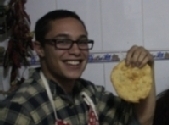
Kenny Stancil
Graduation Year: 2013
Location: Santiago, Chile
Project Title: Confronting Neoliberalism and Creating Spaces of Transformation through the Chilean Students Movement: FAU “en toma” 2011
Brief Summary of Research Project:
I returned to Santiago for five weeks during the summer of 2012 to learn about how Chilean students have made use of space throughout their movement for free, quality public education. I focused in particular on the five-month long occupation of the University of Chile’s school of architecture, urban studies, and geography. Through interviewing thirteen students and a professor, I found that in addition to mobilizing to universalize access to education by redefining it as a social right, students have appropriated their campuses as a way of questioning the production of knowledge. Inspired by Paulo Freire, students are asking what do we learn, how, and why? They desire to build a critical pedagogy that converts education from a method of reproducing the status quo into an instrument of liberation.
Biggest Challenge: Even though I had studied for a semester in Chile the previous year, my biggest challenge was still related to language. The speed with which Chileans speak, plus their unique accent and specific vocabulary created some communication difficulties. Luckily, the students that I met with were understanding and willing to repeat/explain some things.
Advice to future Wang Grant applicants and/or recipients:
Applicants – Start your application by J-term at the latest. From brainstorming ideas to turning it in by late February, there is quite a bit of work involved. Talk with professors! They can be such a big help, from generating interesting questions, to suggesting useful books and/or articles to read, to developing a methodology. Remember that you’ll also need a letter of recommendation eventually.
Recipients – If you have a contact, such as a professor that will provide some guidance, be in touch with him or her. The more defined your project is before you arrive, the better. Also, before you arrive, try to complete as much of the necessary reading as you can. This will help you with your theoretical framework, and it will leave you more time to carry out interviews or whichever other method of observation you choose.
How the Wang Grant has helped me academically or personally:
The Wang Grant has definitely helped me! I had been fairly certain for about a year or so that I wanted to delve into human geography after PLU. This experience confirmed that desire. I learned a little bit more about how space is produced and utilized, which is a central concern of geographers. Thinking about the spatial dynamics of an urban social movement gave me the chance to read about how people appropriate space as a way to make societal transformation possible. This is captured in Henri Lefebvre’s idea of the Right to the City, a concept that has been invoked more recently by Don Mitchell and David Harvey, among others. It was invigorating to read works by these influential geographers and to observe the convergence of social theory and social action.
Before learning about the significance of the 2011 ‘toma’ de la FAU, I had this misconception that the weekly, bi-weekly, or sometimes monthly marches were the most important expression of the student movement. Don’t get me wrong, the actions in the streets are absolutely vital. However, they are relatively temporary compared to the more permanent nature of a ‘toma.’ The more I thought about it, the more I realized that the mobilizations weren’t appearing out of thin air. In fact, I started to see the ‘tomas’ as a sort of motor of the student movement. The Chilean students aren’t fighting strictly for a cost-free education, important as the affordability aspect of the struggle is. In addition to universalizing access to education, they are working to construct a quality education of a public nature. “Quality” is actually a term of struggle. For elites, a quality education is one that best corresponds to market forces. But one student put it clearly when he said that they turn their backs on the market. This is because the Chilean students are much more concerned with developing an education that meets social needs.
This is directly connected to the fact that the students recognize that an education system can’t really be neutral–it either reproduces the unjust status quo or challenges it. One of the students boiled it down to three questions: What do we learn, how, and why? They really peaked my interest in reading Paulo Freire’s Pedagogy of the Oppressed, which is a landmark text in the field of critical pedagogy. I believe that through the ‘tomas,’ the students are building a critical pedagogy. A cost-free education is imperative and would be a monumental step in the student movement. However, if an affordable education continues to produce subjects who are obedient to corporate orthodoxy, then it wouldn’t result in the kind of changes that many of the students want to see. A key question that emerges is what kind of education will be provided as a social right that is available to all people? If we are to fundamentally transform our social structure, then the need to transform education into an instrument of liberation makes a lot of sense. Since this experience, I haven’t gone one day without thinking about the relationship between education and social justice.



Social Media